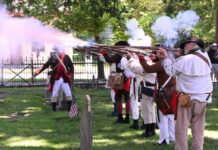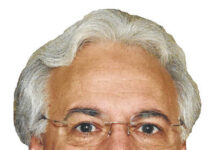A railroad crossing sign and the blasting horn of an approaching train weren’t enough to stop a motorist who narrowly escaped getting hit on East Market Street in downtown Wilkes-Barre one recent morning.
Video of the incident, attached to this story, shows the chilling close call as a blue Subaru speeds across the tracks only feet ahead of a moving freight train.
It was anything but a fluke, however.
With no flashing lights or gates to warn drivers at several grade crossings in the city, drivers commonly race across the rails to beat oncoming trains — even though the lumbering locomotives loudly blow their horns, and even though motorists are required to stop and yield the right-of-way-to trains.
It’s a “major issue,” said Andrew Reilly, executive director of the Luzerne County Redevelopment Authority, which owns the track. The Luzerne Susquehanna Railway, the company that maintains and operates trains on the line, informed him motorists regularly fail to halt as required.
“There have been several near misses, and even when rail workers get out to stop and flag, the flaggers are endangered,” Reilly said.
But such close calls also raise questions about whether more could be done to prevent potential tragedies, such as installing better warning equipment for motorists.
• See the official Times Leader video at https://youtu.be/iVAc0U1yh2U
• See video and commentary from DuPuis at http://bit.ly/dupuis_train_video
Costly solutions
In a perfect world, every crossing would have flashing lights and gates that lower to block the roadway, Reilly said. However, such enhancements cost approximately $300,000 each due to the electrical work involved, and that price does not include mandatory ongoing maintenance, he said.
The tab for lights and gates typically falls on both the municipality and rail owner, officials said.
The authority is not in a strong financial position because any money it generates from the rail operation must go toward repayment of $1.8 million owed to the county and $1.56 million due to the county community development business loan fund.
County officials had provided this funding in 2001 because the authority was in danger of defaulting on its mortgage and losing ownership of its 55-mile track network. About 25 businesses served by the rail line had pushed for county financial assistance at that time, saying $50 million in salaries and thousands of jobs were in jeopardy.
Wilkes-Barre City Operations Director Butch Frati said the city would have to seek grants or other outside funding to cover such an expense because there is no available money in the general fund operating budget, and other available existing accounts could not be used for that purpose.
Frati said he has witnessed motorists taking chances ahead of oncoming trains at some of the at-grade railroad crossings in the city, but he could not recall any pushes for the addition of more safety measures.
The city would comply with any requirements imposed on it, he stressed.
Enforcement
Decisions on which warning measures are required at crossings are made by the Pennsylvania Public Utility Commission, or PUC.
In its assessments, the agency examines visibility, road and rail traffic, accident reports, a crossing’s history and other factors, said commission spokesperson Nils Hagen-Frederiksen.
Reviews can be triggered by complaints or issues observed by inspectors and requests from municipalities or rail owners/operators, he said.
Five rail lines operate in the county, Federal Railroad Administration information shows.
There are 157 at-grade railroad crossings on public roadways in Luzerne County, which is the fourth highest among the state’s counties, according to FRA statistics.
Of those, 52 rely on X-shaped signs — known as crossbucks — as opposed to flashing lights and gates, the statistics show.
PUC records show no concerns raised about the safety of the East Market Street crossing, Hagen-Frederiksen said.
The railroad speed limit also is set at 10 mph at the Wilkes-Barre crossings, and train operators must blow their horns, he said.
Train operators also are required to stop and send flaggers out ahead of their train to make sure the path is clear if the approved warning devices — signs, lights or gates — are missing or not operational, he said.
At the nearby Butler Street crossing in Wilkes-Barre, for example, Luzerne Susquehanna Railway must use flaggers because the lights and gates are no longer functional, he said.
The rail operator sought PUC permission to remove the lights and gates. The PUC has granted that permission if the operator continues to send out crews to flag the crossing, in part because motorists may be accustomed to relying on lights and gates to warn them at that location, said Hagen-Frederiksen.
Funding is ‘complicated’
What about upgrading other crossings? The PUC can order rail crossing safety improvements, but the agency has no funding mechanism to pay for those upgrades.
A combination of municipal and railroad funding is often required — state funding if the crossing is on a state highway, Hagen-Frederiksen said, describing the process as “complicated.”
“The cost is typically the primary reason why there ends up being disputes over rail crossings,” he said. “The PUC can direct changes to be made, but if dollars are not there to fund the work, it’s a challenge.”
Because some crossbuck signs are missing along the Luzerne County Redevelopment Authority line, train crews must be sent out more often to flag, according to the rail operator and the authority.
The authority board voted last week to allocate up to $12,000 to install replacement signs, Reilly said. A consultant is performing an inventory to verify the locations and number that must be purchased.
Even some of those which are in place are difficult to see.
At the Northampton Street crossing in Wilkes-Barre, for example, one of the signs is blackened with rust and has lost its reflective coating. The rail operator said plans are also in the works to replace that sign.
‘Motorists have responsibility’
At East Market Street, where Times Leader staff have witnessed and documented close calls, the signs are still bright white with crisp black lettering.
If motorists on the busy city thoroughfare do see those signs, many don’t seem to be heeding their warning, frequently scooting across as trains approach.
The recent close call captured on the Times Leader’s video highlights the requirement for motorists to yield at crossbuck signs, Hagen-Frederiksen said.
“Motorists are required to yield the right of way to trains and also — like any other yield — to make sure it’s safe to cross,” he said. “It’s important to understand motorists have a responsibility.”
To reinforce this mandate, the Federal Railroad Administration is requiring the addition of yield signs at all crossings that rely on crossbuck signs next year, he said.
Hagen-Frederiksen supports this initiative because there are many crossings nationwide with signs alone, because they don’t have the traffic volume to force the expensive installation and maintenance of gates.
“There are thousands of crossings across the country marked with the standard crossbuck, and you can’t have someone sitting at every one to make sure motorists take proper precautions,” he said, noting the responsibility to enforce the motor vehicle requirement falls on police.
Motorists also may be uncertain about the yield requirement, and vehicles increasingly block out more sound, particularly if drivers are listening to music, he said.
Purposefully trying to beat a train is a dangerous risk because trains can’t instantly stop like a road vehicle.
“A train striking a car is the equivalent of a car hitting a soda can due to the mass, momentum and energy,” Hagen-Frederiksen said.
Jim Raffa, Luzerne Susquehanna’s sales and marketing vice president, said he’s observed more motorists failing to yield at crossing signs, which he attributes to an ignorance of the law and increase in texting and cell phone use while driving.
Loud freight trains don’t seem to make a difference, even with horns blowing and bells ringing, he said.
“We make a lot of noise when we’re coming through,” said Raffa.
Gates and lights are not warranted, he said, due to the cost and because his trains pass through Wilkes-Barre only twice a day on weekdays.
“Somebody has to pay for it, and nobody has money. The city is broke,” he said.
The passage through crossings also has become increasingly stressful for train operators because they can’t force vehicles to get out of the way, Raffa said.
And as motorists too often forget, trains can’t swerve or stop quickly, even at low speeds.
”When there’s an accident — or even worse, a fatality — they carry it with them the rest of their lives,” Raffa said of train crews.







